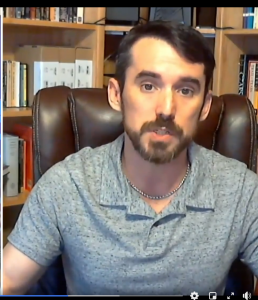by Dave Waddell
An ex-cop who researches police use-of-force issues says an excessive number of shots were fired by Chico police officer Tyler Johnson in his October killing of Stephen Vest.

At a Jan. 14 media briefing, Butte County District Attorney Mike Ramsey ruled that Johnson, who fired nine shots, and police Sgt. Nick Bauer, who shot twice, were justified in killing Vest and would face no criminal charges. Vest, 30, was in a meth-fueled mental crisis and holding a knife when shot.
Vest was hit by a total of eight police bullets, including six rounds from Johnson’s 9mm Glock. Johnson shot Vest twice in the chest, once in the shoulder, twice in the back, and once in the back of the neck. Video from Johnson’s body-worn camera indicates the neck shot came when Vest was on his knees, head bowed, falling forward. The barrage of bullets ended with two final rounds into Vest’s back as his midsection touched the asphalt.
Neither of Bauer’s shots from his .45 caliber Glock — one hitting Vest’s shoulder, the other his leg — was fatal, Ramsey said. Bauer first fired at about the same instant Johnson was pulling his trigger for the fifth time. One of Johnson’s errant bullets is believed to have passed through a bag of kitten food inside the window of the nearby Petco and was not found.

Butte County DA Mike Ramsey
Seth Stoughton is an associate law professor at the University of South Carolina who co-authored the book “Evaluating Police Uses of Force.” He was a Tallahassee, Fla., police officer for five years and a state investigator for three years before attending law school. Stoughton viewed a two-frame video produced by Ramsey that captured simultaneously the body camera footage of Johnson and officer William Page, who shot Vest with a stun gun just before he was gunned down. Sgt. Bauer did not turn on his body camera prior to the shooting.
Vest was walking silently toward the officers, while holding a knife with a 3 ½-inch blade at his side. The probes from Page’s Taser hit Vest in the pelvis and chest, briefly slowing and staggering him as he slightly changed direction toward Johnson. Johnson started firing his Glock when Vest was about 12 feet away, according to Ramsey. The body cam video shows Vest beginning to fall with Johnson’s first or second shot.

“It takes a short period of time for an officer to reassess the situation and to calibrate their actions appropriately,” Stoughton wrote in an email reply after viewing the video. “But that doesn’t give officers carte blanche to keep shooting while someone has fallen to their hands and knees, then entirely to the ground. By shot 4, it doesn’t appear that the individual (Vest) presents any more of a threat. *Maybe* the next couple of shots are understandable, but the shots … continue even after that.”
Ramsey’s report, while acknowledging that officers fired several shots after Vest was not a threat, claims that “it is standard in neuropsychology that it takes time for an officer (or anyone) to ‘put the brakes’ on a motor activity (like shooting) once it has started. … Most studies show this ‘time to stop’ can vary up to a second to a second and a half.”
The reaction time Ramsey claims in the Vest killing is considerably longer than what the DA purported it to be in the 2017 gunning down of Desmond Phillips by Chico police. Then, Ramsey’s report claimed “the reaction shutdown time can normally be around a ½ second.”
Asked for research citations to support his varied claims, Ramsey provided a journal article in which the lead author was William Lewinski, executive director of the Force Science Institute.
Stoughton, the ex-cop and law professor, said Force Science puts out a lot of information about police uses of force, but “some of their research is not very good” and sometimes arrives at poorly supported conclusions.
“Force Science research is not very highly regarded by most traditional academic researchers,” Stoughton said in a telephone interview. “It is very well regarded with police … because it almost always works to the benefit of the officers.”
Lewinski was the subject of a 2015 New York Times story, headlined: “Training Officers to Shoot First, and He Will Answer Questions Later.” Lewinski’s conclusions, wrote the Times’ Matt Appuzo, “are consistent: The officer acted appropriately, even when shooting an unarmed person. Even when shooting someone in the back. Even when witness testimony, forensic evidence or video footage contradicts the officer’s story.”
A headline over a story in New York magazine dubbed Lewinski’s research “junk science.” The story cited several research problems.
The Vest investigation is Ramsey’s first under a year-old state law, Assembly Bill 392, that changed the circumstance under which deadly force by police is legally justifiable from “reasonable” to “necessary.”
How necessary was it for police to kill Vest, who was advancing from 12 feet away holding a knife but not in an attacking manner?
“That young man did not need to die” — Margaret Swick
Not very, based on research by Franklin Zimring, author of “When Police Kill,” which calls the protection of police from life-threatening attack “a peculiar mix of high operational priority and low scientific knowledge.”
Zimring studied the 292 deaths from “felonious assaults on police” in the U.S. during the six-year period of 2008 through 2013. Two of those deaths (0.6 percent) were by knife or other cutting instrument. (In the study, an officer was more likely to die by beating, and just as likely to die by bomb, as by knife; the overriding threat to police safety are men with guns.)
“The only deaths that came from knives,” wrote Zimring, “were in the cases of two attackers who had hidden small knives and produced them when in close proximity to an officer … Attackers who brandish knives and rush at police … never caused a death of an officer in six years. One wonders whether such weapons should really be considered deadly weapons when police in uniform are the targets. If these are not deadly weapons, then the hundreds of killings each year by officers responding to the brandishing of such weapons might not appear to be necessary to protecting the lives of American police.”
Margaret Swick of Chico, a member of the police reform group Concerned Citizens for Justice (CC4J), said in a phone interview shortly after Vest’s death that “Chico’s got to stop shooting people. They’re supposed to bring people before a judge. I’m not sure they understand that anymore. … That young man did not need to die. Period.”

In an email response after Ramsey’s findings cleared Johnson and Bauer, Swick wrote: “Nothing has improved or changed in policy or behavior following any local police killing. Nothing prevents shootings from happening again and again. If we follow the DA report that there was not time for de-escalation then obviously there will not be time to de-escalate in future incidents. We cannot accept that.”
Ramsey, at the press conference, abruptly dismissed a question about whether Johnson, as an alternative to stand-your-ground use of deadly force, could have retreated to his immediate right further into the Petco parking lot. It would have been a move known in police parlance as “creating time and distance.” Ramsey claimed Johnson’s parked patrol vehicle blocked his rightward path, yet the DA’s own video animation shows Johnson situated behind his car while firing, with an open path to his right.
Vest had a history methamphetamine abuse after the 2018 Camp Fire rendered him homeless. Ramsey diagnosed Vest’s mental condition — both on the night he was killed and previously — as meth-induced psychosis. During 2019 and 2020, Vest had numerous encounters with Chico police. Most, Ramsey said, were “uneventful.”
However, Vest was convicted of two felonies in what Ramsey described as “attacks” on officers while in mental crisis. Neither involved any use of weapons. Vest twice bit an officer’s leg, “twisted” an officer’s ankle and “severely twisted” an officer’s thumb. During one biting incident, Vest repeatedly attempted to slam his own head against the sidewalk.
In the minutes leading up to his death, Vest damaged the vehicles of a private security guard and of frightened motorists at MLK Parkway and East 20th Street. “Vest used his knife to stab at passing vehicles in the intersection – breaking at least one windshield; slapping his bloody hands on the windows of passing cars; slashing at tires; and jumping onto the rear of a passing motorcycle,” says Ramsey’s report.
Vest then walked to Petco, scaring its employees and a delivery driver. He “got up into the rear of the delivery truck and began throwing items out of the truck and banging his head on pallets of goods inside,” Ramsey wrote. As the workers fled, Vest walked into and out of Petco and then toward the police in the parking lot. Johnson started firing within seconds of exiting his vehicle.
A nagging “what if?” also came out of Ramsey’s media event. The DA said Bauer’s regular vehicle, on the day Vest died, was in the shop. When the sergeant went to grab a “less lethal” beanbag shotgun, to his surprise there wasn’t one in the replacement vehicle.
Ramsey’s lengthy report spends 5½ single-spaced pages detailing Vest’s background, while summarizing all three officers’ histories in a total of 65 words. Bauer is a 14-year Chico PD veteran, while Johnson has been with the department two years after a decade with Gridley PD. Left out of the report were possible conflict-of-interest issues related to Sgt. Bauer that were first reported by ChicoSol and have been cited by CC4J, which has called on Chico PD to transform its culture and training practices to reduce police homicides.
Bauer was a member of Ramsey’s Butte County Officer Involved Shooting/Critical Incident Protocol Team before his promotion to sergeant a couple of years ago. On that protocol team, Bauer worked with DA’s office investigators and other detectives from an array of Butte County law enforcement agencies. Bauer wrote investigative reports for at least three officer-involved shootings from 2015 through 2018. Included among those was the infamous Patrick Feaster case in which Ramsey, after the protocol team’s investigation, concluded Feaster should face no criminal charges. (Months later, after considerable criticism, Ramsey reversed himself and successfully prosecuted Feaster for involuntary manslaughter. Feaster was incarcerated for 90 days.)
Ramsey’s teams have investigated 35 officer-involved shootings since the protocol’s adoption by Butte County law enforcement agencies in 1996. Not once has a report coming out of the team’s investigation recommended any criminal charges against any killing officer.
There have been a total of eight officer-involved shootings in Butte County beginning with Desmond Phillips’ controversial killing in 2017 through Vest’s death last year. Five involved the Butte County Sheriff’s Office and three Chico PD.
Ramsey has still not issued a report on the January 2019 killing of Richard Moulton. The Butte County Counsel’s Office has denied access to the Moulton shooting records, claiming Ramsey and Sheriff Kory Honea have not completed their investigations into the two-year-old shooting. Nine Butte County sheriff’s deputies — Brad Meyer, Josh Brazzi, Jake Smith, Tyler Dentinger, Tristan Harper, Mariah Smith, Ben Cornelius, Paul Brodie and Angelo Tavelli — fired guns at Moulton.
Dave Waddell is a contributor to ChicoSol on police-related topics.

I made a donation to ChicoSol to thank Dave Waddell for this revealing article. It is well researched and exposes the disturbing ommissions, speculations, and disingenuous facts DA Ramsey included in his report that justified the killing of a young man experiencing a mental crisis. Everyone should watch the video of the officers shooting down Stephen. His killing is offensive to any reasonable person. The quick use of firearms shows that Chico PD is instructing their officers to use cowboy justice and to shoot first and ask questions later. In my POV this was a criminal act and DA Ramsey should be filing charges. Stephen’s civil rights were violated. Officer Johnson used excessive force in violation of AB392. Sergeant Bauer left his “less than lethal” bean bag” shooting shotgun in another vehicle denying Stephen the chance to survive this interaction, a criminal act. Sergeant Bauer also forgot to turn on his body-worn camera, not a criminal act, but a violation of Chico PD policy. The entire justification report is tainted. DA Ramsey allowed Sergeant Bauer’s law enforcement buddies on the Butte County Officer-Involved Shooting/Critical Incident Protocol Team to investigate the killing. This is a blatant conflict of interest and shows the DA’s disdain for impartiality. The DA’s press conference was a farce and demonstrated the utter failure of Chico PD and its leadership to value human life. Ramsey opined that it was methamphetamines that killed Stephen. That is a pile of garbage. Any reasonable person can clearly see that trigger happy cops are responsible for killing Stephen.